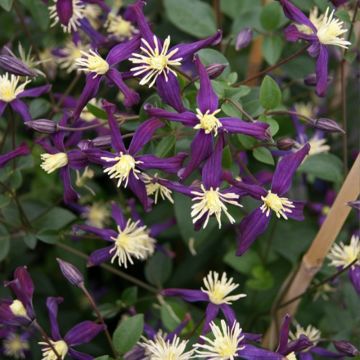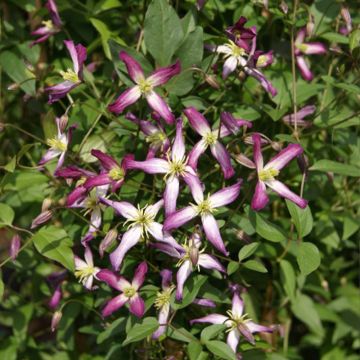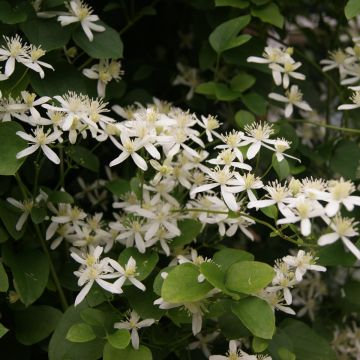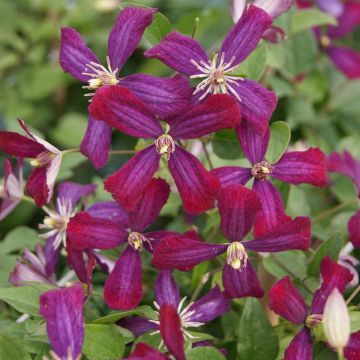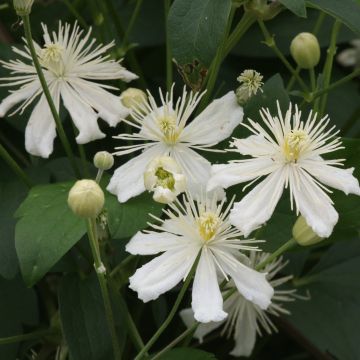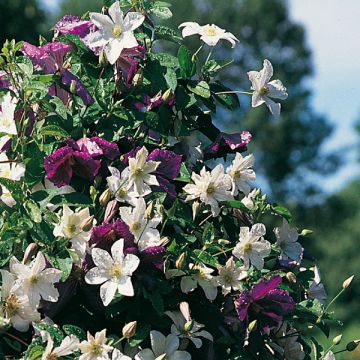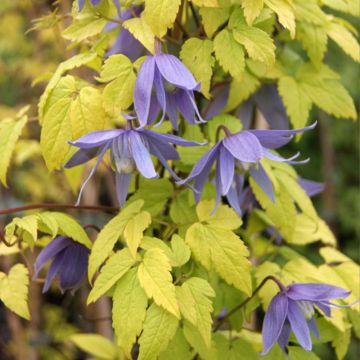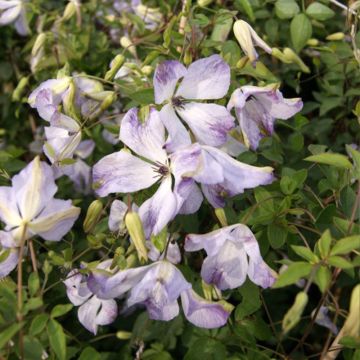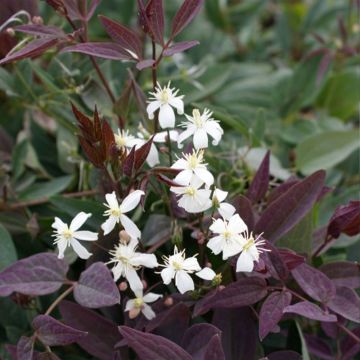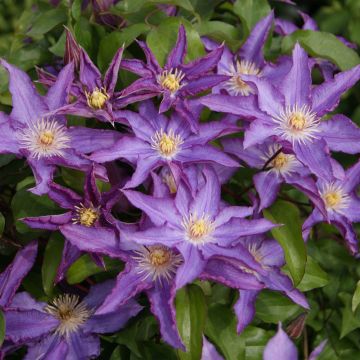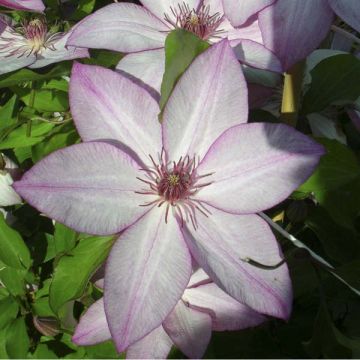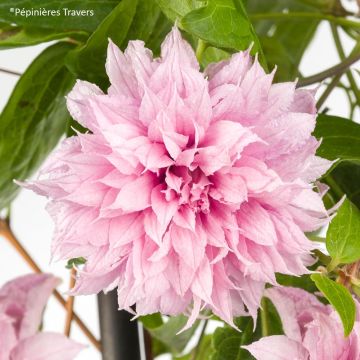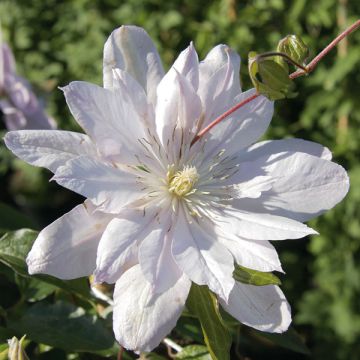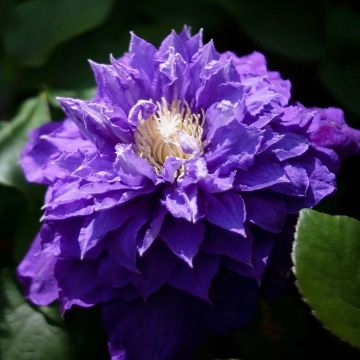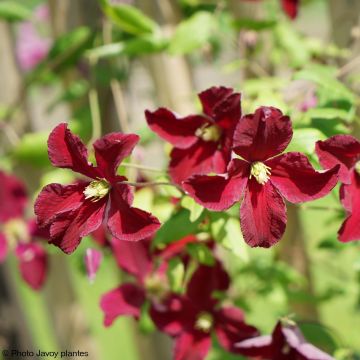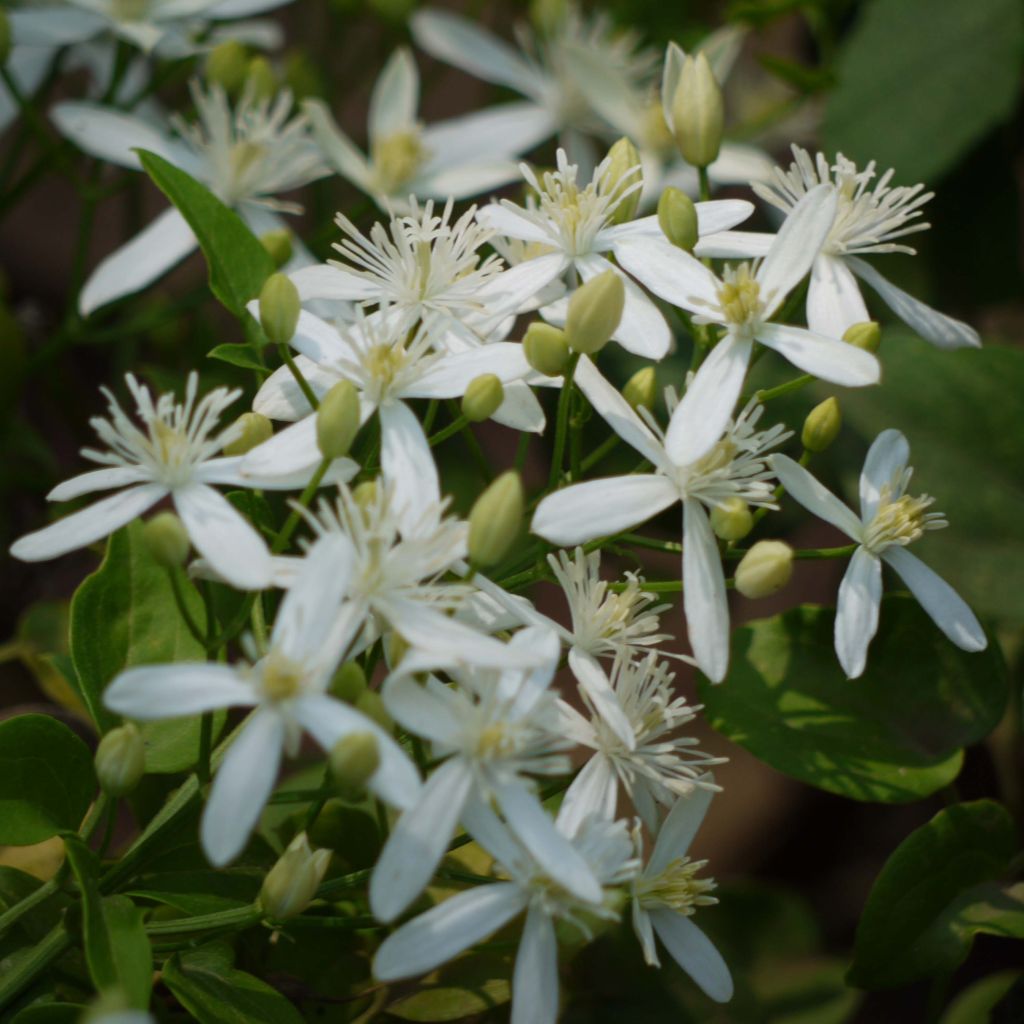

Clematis flammula - Virgin's bower
Clematis flammula - Virgin's bower
Clematis flammula
Fragrant virgin's bower, Sweet-scented virgin's bower
This plant carries a 6 months recovery warranty
More information
We guarantee the quality of our plants for a full growing cycle, and will replace at our expense any plant that fails to recover under normal climatic and planting conditions.
From €5.90 for pickup delivery and €6.90 for home delivery
Express home delivery from €8.90.
From €5.90 for pickup delivery and €6.90 for home delivery
Express home delivery from €8.90.
Does this plant fit my garden?
Set up your Plantfit profile →
Description
Clematis flammula is a vigorous climbing plant. The sweet scent of its white flowers, perceptible from several metres away, reveals the presence of this rather modest-looking plant. At the end of summer, it produces an abundance of discreet little flowers that are incredibly popular with bees. The flowers give way to beautiful silky and silvery fruits. Let it climb in an informal hedge or run on a barren bank.
Clematis flammula belongs to the Ranunculaceae family. It is native to the Mediterranean basin. Its hardiness is moderate (maximum -15°C (5°F) for a short period), and it may freeze in the coldest regions during harsh winters. It is a semi-woody and climbing perennial plant, with woody climbing stems, reaching 2 to 3m (7 to 10ft) in height, with a spread of 1.5m (5ft). Flowering takes place from July to early September on the current year's shoots. The small star-shaped flowers are numerous, gathered in loose panicles. They do not exceed 2cm (1in) in diameter and have 4 white tepals. The flower's centre is adorned with white stamens and pale-yellow anthers. The scent of the flowers is most noticeable in the evening, with hints of bitter almond and honey. The flowering is followed by decorative silver-grey and feathery fruits that persist until winter. The shiny dark green leaves are divided into 3 to 7 narrow leaflets. The foliage is mostly deciduous, but can persist in certain conditions. This clematis clings to the support or host plant through its young petioles that curl like tendrils.
Plant your clematis alongside climbing roses, in a flowering hedge, to hide unsightly walls, or adorn a pergola, fence, or old tree. It is a genus rich in diversity, with varieties of all colours, shapes, and sizes. This modest-sized clematis is truly undemanding. It is perfect for dry gardens where other clematis suffer. It will be perfect both in the garden and in large pots. Its numerous tendrils help it to climb everywhere. Use it to cascade in a warm rockery or as ground cover on a barren bank. This lovely climber will bring a natural and charming touch to your garden with minimal maintenance.
Report an error about the product description
Clematis flammula - Virgin's bower in pictures


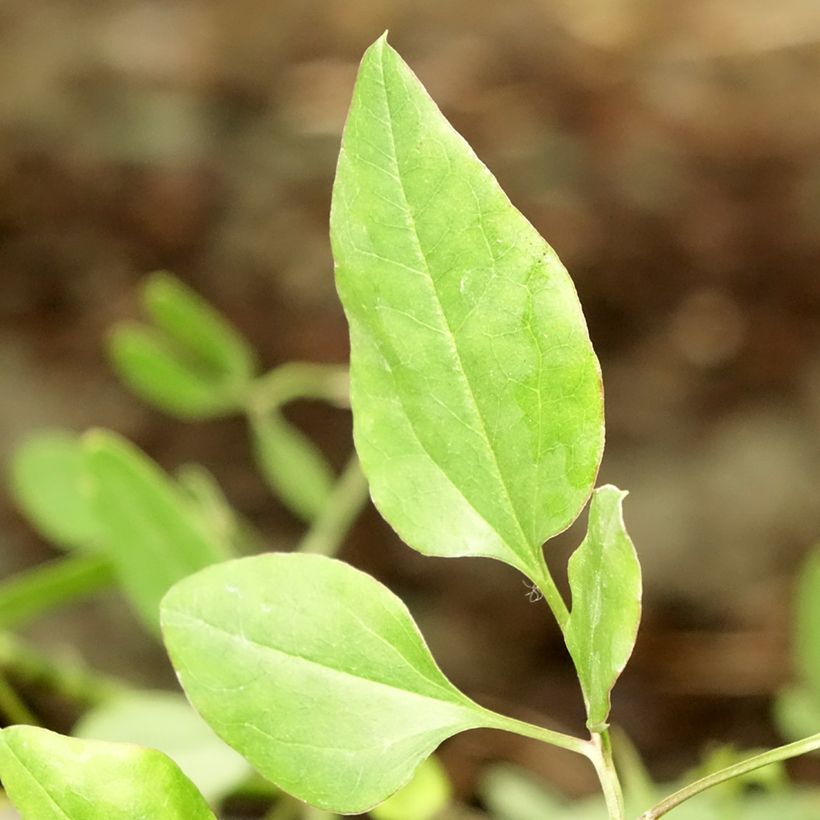

Plant habit
Flowering
Foliage
Botanical data
Clematis
flammula
Ranunculaceae
Fragrant virgin's bower, Sweet-scented virgin's bower
Mediterranean
Other Clematis Flammula
Planting and care
Clematis flammula will appreciate a sunny or semi-shaded position. Plant it in spring or early autumn in regular but well-drained soil. It will tolerate sandy or rocky, slightly acidic, neutral or alkaline soil (contrary to what is often read, this species appreciates both sandy dunes and rocky limestone areas). The cold resistance of a mature and well-rooted plant is estimated at -12 to -15°C (10.4 to 5°F) at the tip. Its hardiness being average, make sure to protect the base in winter. Once established, the climbing clematis can do without watering, even in hot and very dry regions in summer.
Improve the soil at planting by mixing the soil from your garden with compost and gravel. Shade the roots and the base of the stem (with a flat tile, for example). Clematis withers in overly wet soil. Work the soil to a depth of 20cm (8in), lightened with good quality compost. Plant it by covering the root ball with 3cm (1in) of soil. Water regularly and generously during the first few weeks. Do not overwater, as stagnant water can lead to the development of fungus at the base of the plant.
Train the stems, without tightening them, until the plant can cling by itself. Clematis also like to grow freely on neighbouring plants.
After a few years, cover the base of your climbing clematis with a small mound of soil to reduce the risk of wilting, while encouraging vigorous shoots from the stump.
Voles and grey worms can attack clematis and devour the stems. Aphids and greenhouse whiteflies are also potential parasites.
Planting period
Intended location
Care
This item has not been reviewed yet - be the first to leave a review about it.
Clematis
Haven't found what you were looking for?
Hardiness is the lowest winter temperature a plant can endure without suffering serious damage or even dying. However, hardiness is affected by location (a sheltered area, such as a patio), protection (winter cover) and soil type (hardiness is improved by well-drained soil).

Photo Sharing Terms & Conditions
In order to encourage gardeners to interact and share their experiences, Promesse de fleurs offers various media enabling content to be uploaded onto its Site - in particular via the ‘Photo sharing’ module.
The User agrees to refrain from:
- Posting any content that is illegal, prejudicial, insulting, racist, inciteful to hatred, revisionist, contrary to public decency, that infringes on privacy or on the privacy rights of third parties, in particular the publicity rights of persons and goods, intellectual property rights, or the right to privacy.
- Submitting content on behalf of a third party;
- Impersonate the identity of a third party and/or publish any personal information about a third party;
In general, the User undertakes to refrain from any unethical behaviour.
All Content (in particular text, comments, files, images, photos, videos, creative works, etc.), which may be subject to property or intellectual property rights, image or other private rights, shall remain the property of the User, subject to the limited rights granted by the terms of the licence granted by Promesse de fleurs as stated below. Users are at liberty to publish or not to publish such Content on the Site, notably via the ‘Photo Sharing’ facility, and accept that this Content shall be made public and freely accessible, notably on the Internet.
Users further acknowledge, undertake to have ,and guarantee that they hold all necessary rights and permissions to publish such material on the Site, in particular with regard to the legislation in force pertaining to any privacy, property, intellectual property, image, or contractual rights, or rights of any other nature. By publishing such Content on the Site, Users acknowledge accepting full liability as publishers of the Content within the meaning of the law, and grant Promesse de fleurs, free of charge, an inclusive, worldwide licence for the said Content for the entire duration of its publication, including all reproduction, representation, up/downloading, displaying, performing, transmission, and storage rights.
Users also grant permission for their name to be linked to the Content and accept that this link may not always be made available.
By engaging in posting material, Users consent to their Content becoming automatically accessible on the Internet, in particular on other sites and/or blogs and/or web pages of the Promesse de fleurs site, including in particular social pages and the Promesse de fleurs catalogue.
Users may secure the removal of entrusted content free of charge by issuing a simple request via our contact form.
The flowering period indicated on our website applies to countries and regions located in USDA zone 8 (France, the United Kingdom, Ireland, the Netherlands, etc.)
It will vary according to where you live:
- In zones 9 to 10 (Italy, Spain, Greece, etc.), flowering will occur about 2 to 4 weeks earlier.
- In zones 6 to 7 (Germany, Poland, Slovenia, and lower mountainous regions), flowering will be delayed by 2 to 3 weeks.
- In zone 5 (Central Europe, Scandinavia), blooming will be delayed by 3 to 5 weeks.
In temperate climates, pruning of spring-flowering shrubs (forsythia, spireas, etc.) should be done just after flowering.
Pruning of summer-flowering shrubs (Indian Lilac, Perovskia, etc.) can be done in winter or spring.
In cold regions as well as with frost-sensitive plants, avoid pruning too early when severe frosts may still occur.
The planting period indicated on our website applies to countries and regions located in USDA zone 8 (France, United Kingdom, Ireland, Netherlands).
It will vary according to where you live:
- In Mediterranean zones (Marseille, Madrid, Milan, etc.), autumn and winter are the best planting periods.
- In continental zones (Strasbourg, Munich, Vienna, etc.), delay planting by 2 to 3 weeks in spring and bring it forward by 2 to 4 weeks in autumn.
- In mountainous regions (the Alps, Pyrenees, Carpathians, etc.), it is best to plant in late spring (May-June) or late summer (August-September).
The harvesting period indicated on our website applies to countries and regions in USDA zone 8 (France, England, Ireland, the Netherlands).
In colder areas (Scandinavia, Poland, Austria...) fruit and vegetable harvests are likely to be delayed by 3-4 weeks.
In warmer areas (Italy, Spain, Greece, etc.), harvesting will probably take place earlier, depending on weather conditions.
The sowing periods indicated on our website apply to countries and regions within USDA Zone 8 (France, UK, Ireland, Netherlands).
In colder areas (Scandinavia, Poland, Austria...), delay any outdoor sowing by 3-4 weeks, or sow under glass.
In warmer climes (Italy, Spain, Greece, etc.), bring outdoor sowing forward by a few weeks.

































